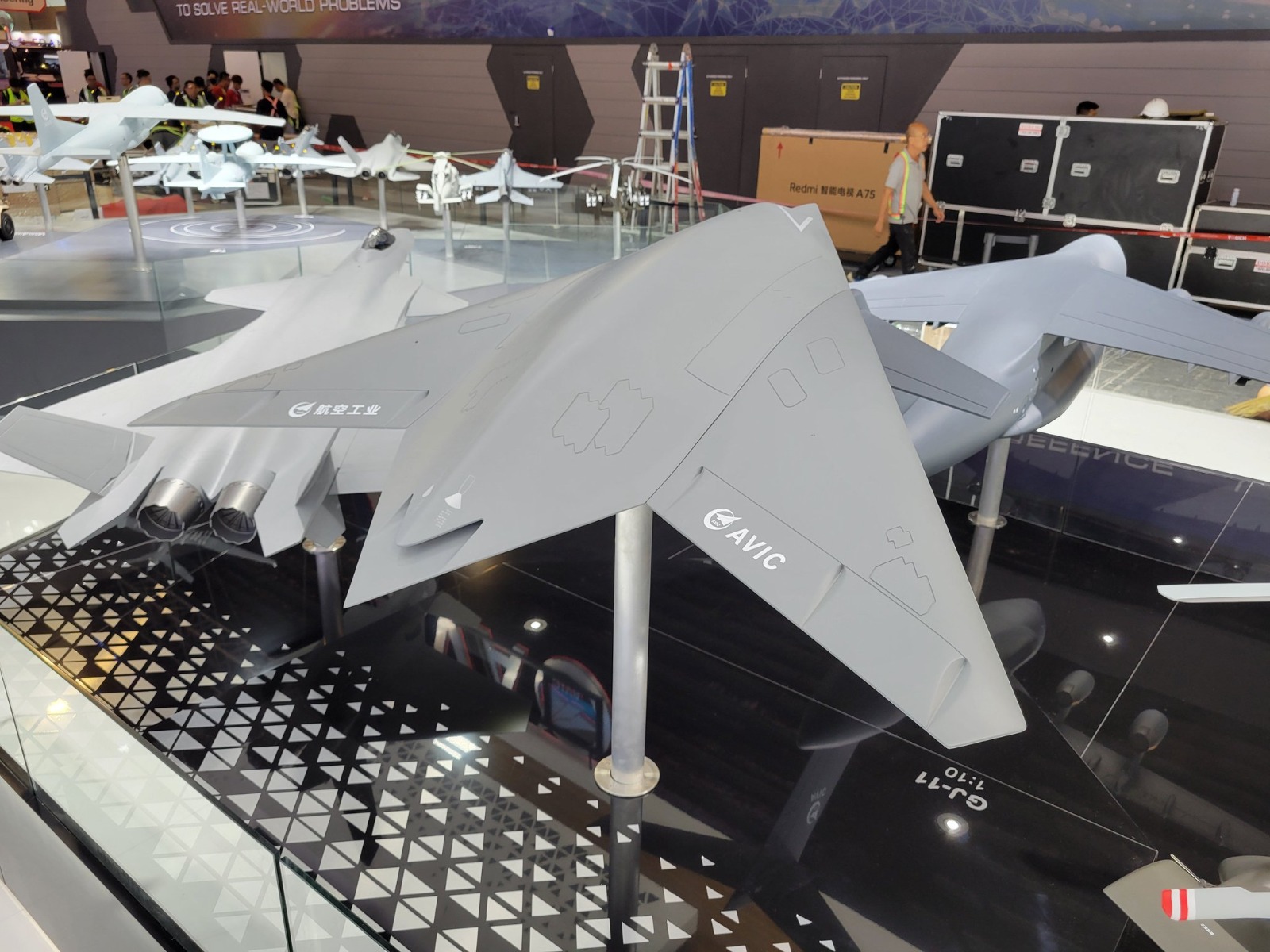Does the showcasing of the GJ-11 Sharp Sword by China in Singapore mean it is looking for exports? Perhaps it is. But more than that, China is sending out a message that the GJ-11 Sharp Sword will play a major role in future naval wars – possibly in the western Pacific and off Taiwan’s eastern seaboard.
China has displayed a scale model of its GJ-11 Sharp Sword unmanned combat aerial vehicle (UCAV) at the ongoing Singapore Air Show. The GJ-11 has been hyped as the J-20’s ‘loyal wingman’ drone and is also slated to fly from the latest Type 004 Fujian carrier.
The exhibition of the drone comes amid unofficial photographs of a mock-up of the drone on a full-sized carrier test facility in late December last year. That is the strongest indication that the UCAV will play a significant role in China’s naval warfare.
The appearance at an international defense exhibition, however, suggests a commercial intention. Why, then, would the Aviation Industry Corporation of China (AVIC) want to display its in-house technological prowess if not to attract potential customers?
Regardless, the appearance of the GJ-11 warrants a look at how the People’s Liberation Army Navy (PLAN) is aggressively pushing to become the first navy with a carrier-launched naval UCAV.
Origins & Leaks
The GJ-11 was first officially revealed in an October 2019 military parade marking the 70th anniversary of the People’s Republic of China (PRC) (or the National Day) and has been widely believed to rival the US stealth RQ-170 Sentinel drone. Developed and manufactured by AVIC, the first photos were only top and side views of the drone mounted on a truck during the parade.

An early photo from 2013 showed a significantly different and larger top air intake and a regular conical exhaust nozzle. Subsequent photos of a scale model in September 2021 during an air show in China showed its two internal belly weapons bays open between two side landing gears.
“Each bay has four ammunitions, which look like guided precision air-to-ground glide bombs. Experts said that the drone would likely carry multiple types of precision ammunition, including larger ones that were not displayed at the air show,” a Global Times report had then pointed out.
It further quoted military aviation expert Zhang Xuefeng saying that the flying wing-shaped drone had high stealth and subsonic cruise capability, coupled with extended range. Narrators on CCTV during the parade said that the GJ-11’s primary mission would be to conduct deep penetrating strikes on critical targets.
The “GJ” in the designation, also meaning ‘gonji’ (Chinese for ‘attack’), is an additional indication that the primary role of the UCAV is strike-oriented.
Role & Function
The present photograph of the scale model at the Singapore Air Show provides a closer look at its flat exhaust nozzle, which is usually adopted to reduce infrared signature.
Another grab from a computer-illustrated concept of the GJ-11 doing the rounds on social media showed a bottom view of it releasing what appears to be a glide bomb from one of its underbelly internal weapons bays.
It can be assumed that the drone might have a limited Intelligence Surveillance and Reconnaissance (ISR) capability. This is because targeting information generation and data linking has been envisaged for all airborne assets as a part of China’s ‘intelligentized warfare’ concept.
Via ACuriousPLAFan/SDF: 😮
Supposedly not a recent image, but still the carrier mock-up and test facility at Wuhan has gained some new aircraft: Visible now are clearly mock-ups of J-15, J-35, KJ-600 and a GJ-11H on the flight deck.
(Image via @伏尔戈星图 from Weibo) pic.twitter.com/UL6uk81zh4
— @Rupprecht_A (@RupprechtDeino) December 19, 2023
Chinese military aviation expert Andreas Rupprecht posted a picture in December last year that showed a land-based mock aircraft carrier facility in Wuhan. That facility had dummies of the J-15, J-35/J-31/FC-31 Gyrfalcon, KJ-600, and a GJ-11 on the flight deck.
Another People’s Liberation Army (PLA) expert, Rick Joe, called this a “near confirmation” that a “flying wing UAV/UCAV is intended for carrier aviation,” adding that the GJ-11 is “likely already being tested.”
A video of a UAV flying overhead that surfaced in October 2022 was claimed as the GJ-11. However, a closer analysis by EurAsian Times concluded that it was the CH-7 Rainbow reconnaissance-strike UAV. Others claimed it was the H-20 bomber.
The UCAV is likely meant to operate from Chinese carriers with flat-top flight decks like the Type 004 Fujian. There has been no indication that it might operate from the Liaoning or the Shandong that have ski-jumps. This is because the carrier on which the mock-up of the full-scale model was placed looks a lot like the Fujian.
Besides, both the Shandong and Liaoning have Short-Take Off Barrier Arrested (STOBAR) launch and recovery systems, where aircraft have to take off on their power from the ski-jumps, forcing them to carry a lighter payload. The Fujian, however, has an Electromagnetic Launch System (EMALS) that can launch heavier aircraft like the J-15, the KJ-600 Airborne Early Warning (AEW) aircraft, and the GJ-11.
Another possible role would be flying alongside the J-20 stealth fighter as a part of a manned-unmanned team. Screen grabs from an October 2022 digital representation on China Central Television (CCTV) showed J-20s and H-6K strategic bombers controlling wingmen drones, and the drones in the video were GJ-11s.
PLAN’s Planning
PLAN would also first focus on mastering the complexity of carrier operations – something that it is doing for the first time and adversaries like India and the US have possessed for decades.
Its priority would be to refine its pilots’ skills, synergize operations of the various crew on the carrier with the flying branch, harmonize formation sailing with other surface combatants, and firm up tactics in consonance with a broader naval doctrine. It is indeed inching closer to this goal, given the near consistency with which the Shandong and Liaoning exercise deeper into the western Pacific and off Taiwan’s eastern seaboard.
Both the Shandong and the Fujian were rapidly built after progressively learning lessons in aircraft carrier construction from the Liaoning, which also means there are improvements in naval aviation operations rather than warship construction.
Moreover, a flying-wingman drone has to be capable of performing autonomously in many routine operations, if not completely free of human control. Autonomous aircraft technology is incredibly complex, requiring sophisticated electronics, flight control algorithms, and software that countries are still refining.
It can be said that China has planned to align the maturation of this homegrown technology with the operationalization of the Fujian, or perhaps a fifth speculated carrier. Even after successfully developing a workable technology, developing tactics, procedures, and maintenance processes with manned fighters and support crew would be the next stage.
A naval GJ-11 would also need to have significantly different airframe durability, a powerful engine, and strong landing gear to withstand the punishing launch and recovery procedures in a demanding aircraft carrier environment.
It must perform everything from providing enhanced surveillance, reconnaissance, and targeting data to its carrier-borne fighters like the J-15 via direct line-of-sight data links. Extending the range and scope of surveillance for PLAN’s carrier battle groups (CBG) is just one part.
Other claims point out that the GJ-11 is also meant to be operated from the Type 075 amphibious landing helicopter docks (LHD) — a central Chinese asset for a military move on Taiwan. Put differently, the GJ-11 becoming a loyal wingman or a carrier-borne UCAV is not a question of ‘if’ but ‘when.’
- The author can be reached at satamp@gmail.com
- Follow EurAsian Times on Google News




